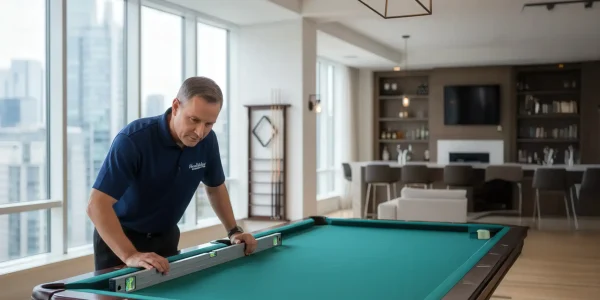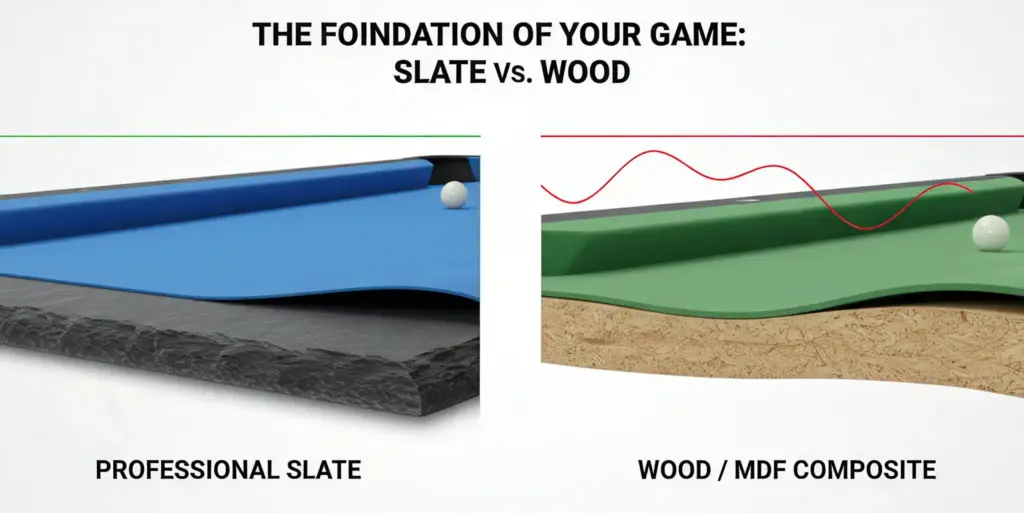A pool table is often the centerpiece of a game room, a stage for friendly competition and skillful play. The cloth, or felt, covering the playing surface is crucial, directly impacting how the balls roll, rebound, and respond. Proper pool table cloth care is not just about appearance; it’s essential for maintaining the quality of play and extending the life of your table. Neglecting the cloth can lead to poor performance, frustration, and eventual costly replacement. Understanding the different types of cloth and the right maintenance techniques ensures your table plays true for years to come. As experts with over 30 years serving the Toronto area and as authorized dealers for premium brands like Brunswick and Olhausen, we understand the importance of meticulous care.
Introduction
The playing surface of your pool table is a precision textile. Whether you have a professional-grade worsted cloth or a durable recreational felt, its condition dictates ball speed, accuracy, and overall enjoyment. Dust, chalk, spills, and general wear can degrade the cloth, affecting gameplay and diminishing the table’s value. This guide provides expert insights derived from extensive research and decades of experience into effective pool table cloth care, covering everything from understanding different materials to implementing consistent cleaning routines.
Understanding Pool Table Cloth Types
Choosing the right cloth is the first step, but knowing its characteristics is key to proper maintenance. Different materials offer distinct playing experiences and require specific care. Key pool table cloth types include:
- Wool Cloth
The most common type, favoured for durability and consistent ball roll. It offers good glare reduction but is less breathable than synthetics. Often blended with nylon for enhanced stretch. Napped pool table cloth (traditional wool felt) has a fuzzy texture and plays slower. - Nylon Cloth
Durable, easy to maintain, and resistant to staining and fading. Like wool, it’s less breathable. Often blended with wool for recreational tables, offering a balance of durability and affordability. - Polyester Cloth
Often used for covers due to toughness and resistance to fading/staining. More breathable than wool or nylon but less absorbent, potentially increasing glare (mitigated by darker colours). - Felt Cloth
Thick, heavy, and highly absorbent, reducing glare effectively. Durable for indoor/outdoor use but can be harder to clean. - Worsted Pool Table Cloth
A premium wool cloth where shorter fibres are combed out, resulting in a very smooth, fast playing surface favoured for American pool. It’s durable, easier to clean pool table felt (as chalk sits on the surface), and requires no break-in period. Brands like Simonis and Hainsworth are known for high-quality worsted options. - Napped Pool Table Cloth
Traditional wool cloth with a raised, fuzzy surface (nap) creating directional play, common on English/Snooker tables. Plays slower and requires careful brushing with the nap. - American Cloth
Designed for faster play, often with a visible weave and non-directional nap. Smoother feel than English cloth. Simonis is a primary example. - English Cloth
Features a fuzzy, velvet-like texture with a directional nap, resulting in a slower game compared to American cloth.
Comparison Table: Cloth Characteristics (Part 1)
| Feature | Wool | Nylon | Polyester |
| Common Uses | General Play | Recreational | Covers |
| Durability | Superior | Durable | Tough |
| Play Speed | Moderate | Moderate | Moderate |
| Glare Control | Excellent | Good | Fair (dark) |
| Maintenance | Moderate | Easy | Easy |
| Breathability | Low | Low | High |
| Cost | Moderate | Affordable | Affordable |
Comparison Table: Cloth Characteristics (Part 2)
| Feature | Felt | Worsted | Napped (Eng) |
| Common Uses | Indoor/Out | Professional | English Pool |
| Durability | Durable | Long-lasting | Moderate |
| Play Speed | Moderate | Fast | Slow |
| Glare Control | Excellent | Excellent | Good |
| Maintenance | Difficult | Easy | Needs Nap Care |
| Breathability | Moderate | High | Moderate |
| Cost | Moderate | High | Moderate |
While DIY care is great, nothing beats a professional tune-up. Our factory-trained technicians can ensure your table plays like new for years to come.
Prefer a Professional Touch?
Essential Pool Table Cloth Care Techniques
Regardless of the type, consistent care is crucial. Gentle methods protect the fibres, ensuring longevity and optimal play.
General Cleaning Principles
- Always use gentle, straight brushing strokes.
- Avoid harsh chemicals, bleach, or abrasive cleaners.
- Soft-bristled pool table brushes are recommended.
- Start at one end and brush towards the other, or centre to edges.
- Clean the brush often.
- Vacuuming is debated; if done, use very low suction with a non-rotating brush attachment, moving gently with the weave/nap.
- Never use high suction or rotating brushes.
- Blot spills immediately with a clean, damp cloth – never rub.
- Cold water is generally best initially.
- For stubborn spots, a mild water/vinegar solution might be used sparingly, but check manufacturer advice first (Simonis advises against vinegar).
- Specialized feltcleaners exist for specific stains like chalk.
- Always test cleaners in a hidden spot.
- Wipe pockets and clean balls regularly.
- A pool table cover is highly recommended.
Specific Cleaning by Cloth Type
- Wool:
Follow general principles. Ensure thorough drying. Spray cleaners like Quick-Clean may work for surface chalk. - Nylon:
Follow general guidelines. Microfiber cloths are good for cleaning balls to prevent chalk transfer. - Felt:
Stick to general principles. Use a white cotton cloth for stains. Blot with warm water; use specialized felt cleaner if needed. Avoid over-soaking. - Worsted (Simonis/Hainsworth):
For Simonis cloth cleaning, the manufacturer recommends their patented X-1 cleaner or carefully vacuuming with a non-rotating brush head. Use a damp cloth for wiping after vacuuming. Consult professionals for stains on Simonis. For Hainsworth, follow general guidelines. - Napped:
Crucial: Brush only in the direction of the nap (head to foot). Vacuum (if used) very gently with the nap. Ironing with a special table iron can maintain the nap direction (not for American/nylon cloths).
Cleaning Summary Table
| Cloth Type | Daily Care | Weekly Care | Stain Notes |
| Wool | Brush, wipe balls | Thorough brush, gentle vac (opt) | Spot clean, mild soap/vinegar |
| Nylon | Brush, wipe balls (microfiber) | Thorough brush, gentle vac (opt) | Spot clean, mild soap/vinegar |
| Polyester | Brush, wipe balls | Thorough brush, gentle vac (opt) | Spot clean, mild soap; cool wash |
| Felt | Brush, wipe balls | Thorough brush, gentle vac (opt) | Blot warm water, felt cleaner |
| Worsted (Simonis) | Wipe balls | Gentle vac (opt, non-rotating) | Contact pro for stains |
| Worsted (Hainsw.) | Brush, wipe balls | Thorough brush, gentle vac (opt) | Spot clean, mild soap/vinegar |
| Napped (English) | Brush with nap, wipe balls | Thorough brush/vac with nap | Spot clean, mild soap/vinegar |
Effective Stain Removal Strategies
Accidents happen. Knowing how to remove stains from pool table felt quickly and correctly is key.
Immediate Action for Spills
- Act FAST.
- Blot immediately with a dry, clean, absorbent white cloth or paper towel.
- Lay it flat, let it absorb.
- Don’t press hard initially.
- Change absorbent material frequently.
- NEVER rub or scrub.
Removing Common Stains
- Food/Drink:
After blotting, gently dab with a cold-water-dampened cloth, working outside-in. Avoid soaking. For tougher stains, try mild dish soap in cold water, dab, blot dry. Rinse cloth often. Diluted white vinegar/water is a last resort (test first). - Chalk:
Regular brushing/vacuuming usually suffices. Specialized removers exist. - Ink:
Use specialized felt cleaners designed for ink. - Grease:
Difficult. Try blotting with mild detergent solution. Complete removal may not be possible.
Safe Cleaning Solutions and Methods
- Start with the mildest method (dry blot).
- Progress to damp cloth (cold water), then mild soap solution if needed.
- Use vinegar solution or specialized cleaners only as a last resort, always testing first.
- Avoid hot water initially.
- NEVER use bleach or harsh chemicals.
- Don’t saturate the cloth.
- Ensure complete drying before use.
Establishing a Consistent Pool Table Maintenance Routine
Regular pool table maintenance prevents buildup and catches issues early. Following a routine similar to Brunswick Billiards – Your Guide to Billiard Table Care and Maintenance can be beneficial.
Daily Care Practices
- Brush after each use to remove chalk/debris. Brush towards pockets.
- Wipe balls with a microfiber cloth.
- Use a pool table cover if prone to dust/spills.
- Avoid eating/drinking near the table.
- Chalk cues away from the table surface.
Weekly Maintenance Steps
- Thoroughly brush the entire surface, including under cushions (use a rail brush).
- Gentle vacuuming (optional, follow guidelines above).
- Wipe down table frame (wood/synthetic parts) with a slightly damp microfiber cloth. Polish wood periodically.
- Clean out pockets.
Monthly Deep Cleaning
- More thorough vacuuming (if applicable).
- Inspect cloth closely for wear/damage. Address promptly.
- Spot clean any new stains.
- Iron napped cloths (if applicable) with a specialized iron.
- Check table levelness.
- Clean pool balls thoroughly with ball cleaner.
Preventing Damage to Your Pool Table Cloth
Understanding common threats helps protect your investment.
Common Causes of Damage
Friction (ball rolling), abrasive chalk dust, scratches (cues/balls), ball burns (hard impacts, less common with phenolic balls), moisture (spills, humidity), sunlight (fading), physical damage (miscues, jewelry, belts), uneven table stress, dirty/chipped balls, excessive chalk, risky trick shots, sitting/leaning (stretching), improper vacuuming.
Strategies for Prevention
- Use a pool table cover diligently.
- Brush regularly and correctly.
- Ensure good room ventilation (dehumidifier if needed).
- Position table away from direct sunlight or use window coverings.
- Use high-quality, clean billiard balls.
- Strictly enforce no food/drink near the table.
- Chalk cues away from the table; use chalk holders.
- Play carefully; avoid overly forceful shots.
- Be mindful of clothing/jewelry near the table.
- Ensure the table is perfectly level.
- Use proper brushing/vacuuming techniques.
- Clean spills immediately by blotting.
- Store cues in racks; keep balls off the table when not playing.
- Use the table only for playing pool.
Damage Prevention Summary
| Cause | Description | Prevention Strategy |
| Friction/Chalk | Abrasive wear | Regular brushing, chalk away, cover |
| Scratches/Burns | Impacts from cues/balls | Careful play, quality balls |
| Moisture/Sunlight | Stains, mold, fading | Cover, no drinks, ventilation, blinds |
| Physical Damage | Rips, tears, stretching | Mindful use, no leaning, store cues |
| Uneven Wear | Table level, dirty balls, vacuum | Level table, clean balls, gentle vac |
Essential Tools for Pool Table Cloth Care
Using the right tools makes maintenance easier and safer for the cloth.
- Recommended Brushes:
Soft-bristled (horsehair/nylon). Often have longer bristles for under rails. Rail brushes specifically clean cushion edges. Under-rail brushes reach difficult spots. Learning how to brush a pool table properly is key. - Vacuum Cleaners (Optional):
Handheld, low suction, must use a non-rotating brush attachment. Extended nozzle helps. Use gently. - Specialized Cleaners/Sprays:
Quick Clean (dry foam for chalk), Cue Silk Cloth Cleaner, Simonis X-1 (for Simonis cloth), Ambersil Cleaner. Mild dish soap/water or vinegar/water (use cautiously). Folex spot remover (some user success). - Microfiber Cloths:
Essential for dusting frame, wiping cloth (damp), blotting spills. Lint-free is best. - Pool Table Irons:
For napped cloths only. Thermostatic, low-medium heat. Use after brushing/vacuuming to reset nap direction. Keep moving to avoid scorching. - Other Useful Items:
Dustpan (soft edge), blotting paper/paper towels, clean white cotton cloths, cue tip maintenance tools, ball cleaner, pool table cover, chalk holder, level.
FAQ
Q: How often should I brush my pool table felt?
Ideally, brush after every playing session to remove fresh chalk and dust. If played infrequently, brush at least once a week. Regular brushing is key to pool table cloth care.
Q: Can I vacuum my pool table cloth?
It’s debated. If you do, use extreme caution: lowest suction setting, only with a non-rotating brush attachment, moving gently with the weave/nap. Some manufacturers (like Simonis) provide specific vacuuming guidance, while others advise against it due to stretching risks. Never use powerful vacuums or rotating brushes.
Q: What’s the best way to clean spills on pool table felt?
Act immediately! Blot gently with a clean, dry, absorbent cloth (white cotton preferred). Do not rub. For residue, dab carefully with a cold-water-dampened cloth. Avoid soaking. Use mild cleaners only if necessary and test first.
Q: How do I know if I have worsted or napped pool table cloth?
Worsted pool table cloth (like Simonis) feels smooth, often has a visible weave, and plays fast. Napped pool table cloth (common on English tables) feels fuzzy, has a directional nap (fibres lie one way), and plays slower. Brushing technique differs significantly.
Q: Is a pool table cover really necessary?
Yes, a pool table cover is highly recommended. It protects the cloth from dust, spills, pet hair, and harmful UV light, significantly extending its life and preserving its playing quality.
Your table is a masterpiece of craftsmanship. Let our insured professionals handle the delicate work of re-felting, moving, or repairs to guarantee a perfect result.
Protect Your Investment
Conclusion
Proper pool table cloth care is an investment in your game and your equipment. Understanding your specific pool table cloth type, whether it’s durable wool, fast worsted pool table cloth, or traditional napped pool table cloth, allows for tailored maintenance. Consistent routines involving regular brushing (learning how to brush pool table correctly, especially with the nap if applicable), prompt spill management (knowing how to remove stains from pool table felt), and preventative measures like using a pool table cover are crucial for pool table maintenance. By using the right tools and techniques, you can clean pool table felt effectively and safely, ensuring a true roll and preserving the beauty and function of your table for years of enjoyment.
For professional pool table services, including re-clothing, repairs, and expert advice in the Toronto area, contact Hallmark Billiards today.





